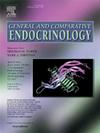染色毒蛙蝌蚪糖皮质激素应激反应的早期发展
IF 1.7
3区 医学
Q3 ENDOCRINOLOGY & METABOLISM
引用次数: 0
摘要
在脊椎动物中,糖皮质激素“应激”反应(皮质酮或皮质醇)通过下丘脑-垂体-肾上腺(HPA)轴影响许多基本功能,包括行为、代谢、免疫和个体发生转变。在发育过程中,如果应激反应促进反捕食者行为和调节发育速度以适应环境条件,则应激反应可能是适应性的;然而,当能量成本过高,发育速度与成熟时的大小和健康相权衡时,这些相同的反应可能会不适应。因此,hpa轴发育的时间可能与物种生活史策略所呈现的特定发育挑战和机遇相一致。在无尾动物(青蛙和蟾蜍)中,皮质酮在发育和行为中起着关键作用,其浓度会随着环境压力的变化而波动。鉴于皮质酮在个体发生变化和行为中的作用,我们研究了染色毒蛙(dendroates tinctorius)蝌蚪糖皮质激素应激反应的发展。染色毒蛙是一种具有独特生活史的物种,包括在陆地上孵化后转移到水中,以及攻击性和同类相食行为。我们测量了自由游泳蝌蚪在运输后和整个变态过程中皮质酮的排泄率和全身皮质酮浓度,以及皮质酮对促肾上腺皮质激素(ACTH)的反应。我们发现皮质酮的排泄率、全身浓度以及皮质酮对ACTH的反应在发育过程中没有显著差异,这表明糖皮质激素反应在个体发育早期就出现了。这一模式不同于其他物种,表明该物种所面临的独特生态压力塑造了该物种糖皮质激素应激反应的发展。更广泛地说,这项研究说明了生活史策略和权衡如何影响压力反应发展的时间。本文章由计算机程序翻译,如有差异,请以英文原文为准。
Early development of the glucocorticoid stress response in dyeing poison frog tadpoles
In vertebrates, the glucocorticoid “stress” response (corticosterone or cortisol) through the hypothalamic–pituitary–adrenal (HPA) axis influences many essential functions, including behavior, metabolism, immunity, and ontogenetic transitions. During development, stress responses can be adaptive if they facilitate antipredator behavior and modulate developmental speed to adjust to environmental conditions; however, these same responses can be maladaptive when energetic costs become too high and developmental speed trades-off with size and health at maturity. Thus, the timing of HPA-axis development may be aligned with specific developmental challenges and opportunities presented by a species’ life history strategy. In anurans (frogs and toads), corticosterone plays critical roles in development and behavior, and concentrations can fluctuate in response to environmental stressors. Given the role of corticosterone in ontogenetic changes and behaviors, we studied the development of the glucocorticoid stress response in tadpoles of the dyeing poison frog (Dendrobates tinctorius), a species with a unique life history that includes transport to water after hatching on land and aggressive and cannibalistic behavior. We measured the excretion rate and whole-body concentration of corticosterone and the corticosterone response to adrenocorticotropic hormone (ACTH) in free-swimming tadpoles after transport and throughout metamorphosis. We found no significant differences across development in excretion rates or whole-body concentration of corticosterone, nor corticosterone response to ACTH, indicating that that the glucocorticoid response develops early in ontogeny. This pattern differs from those in other species, suggesting the unique ecological pressures faced by D. tinctorius have shaped the development of the glucocorticoid stress response in this species. More broadly, this study illustrates how life history strategies and tradeoffs impact the timing of the development of stress responsivity.
求助全文
通过发布文献求助,成功后即可免费获取论文全文。
去求助
来源期刊

General and comparative endocrinology
医学-内分泌学与代谢
CiteScore
5.60
自引率
7.40%
发文量
120
审稿时长
2 months
期刊介绍:
General and Comparative Endocrinology publishes articles concerned with the many complexities of vertebrate and invertebrate endocrine systems at the sub-molecular, molecular, cellular and organismal levels of analysis.
 求助内容:
求助内容: 应助结果提醒方式:
应助结果提醒方式:


